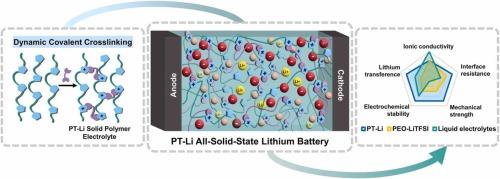Cationic dynamic elastomer electrolyte enabling all-solid-state lithium batteries
IF 17.1
1区 材料科学
Q1 CHEMISTRY, PHYSICAL
引用次数: 0
Abstract
Elastomeric solid polymer electrolytes (SPEs), exhibiting excellent toughness and interfacial stability with lithium (Li) metal anodes, are promising electrolytes for safe and durable all-solid-state Li-batteries. However, many elastomeric SPEs suffer from low conductivity, necessitating addition of liquid electrolytes which can compromise mechanical integrity and cause leakages. Herein, we introduce a fully solid-state elastomeric poly(triazolium) (PT-Li) SPE, which integrates the principles of poly(ionic liquid) (PIL) and covalent adaptable network (CAN) -based electrolytes to achieve enhanced performance characteristics. Like PILs, PT-Li possesses a wide electrochemical window (up to 5.2 V). Meanwhile, like CANs, dynamic triazolium crosslinking enables PT-Li to remain mechanically robust when cycling (shear loss factor ≤ 0.2 at 60 °C) while facilitating (re)processing under heat and pressure. Additionally, the cationic triazolium moieties facilitate Li+ -ion mobility (ionic conductivity, σ = 3.2 × 10−5 S cm−1 at 30 °C, 2 × 10−4 S cm−1 at 60 °C; lithium transference, TLi+ = 0.74). This enabled PT-Lis to exhibit excellent cycling performances in all-solid-state Li | LiFePO4 cells with uniform Li+ deposition at the Li anode interface and enhanced rate capability. The tunability and (re)processability enabled by dynamic covalent crosslinks represent a promising strategy for the development of robust all-solid-state lithium batteries.

实现全固态锂电池的阳离子动态弹性体电解质
弹性固体聚合物电解质(spe)具有优异的韧性和与锂(Li)金属阳极的界面稳定性,是安全耐用的全固态锂电池的理想电解质。然而,许多弹性体spe的导电性较低,需要添加液体电解质,这可能会损害机械完整性并导致泄漏。在此,我们介绍了一种全固态弹性聚三唑(PT-Li) SPE,它集成了聚离子液体(PIL)和共价自适应网络(CAN)电解质的原理,以实现增强的性能特征。与pil一样,PT-Li具有宽的电化学窗口(高达5.2 V)。同时,与can一样,动态三唑交联使PT-Li在循环(60°C时剪切损失因子≤0.2)时保持机械坚固性,同时便于在热和压力下进行(再)加工。此外,阳离子三唑基团有利于Li+离子的迁移(离子电导率,30℃时σ = 3.2 × 10-5 S cm-1, 60℃时σ = 2 × 10-4 S cm-1;锂转移,TLi+ = 0.74)。这使得PT-Lis在全固态Li | LiFePO4电池中表现出优异的循环性能,在Li阳极界面上均匀沉积Li+,并增强了倍率能力。动态共价交联所具有的可调性和可加工性是开发坚固的全固态锂电池的一个很有前途的策略。
本文章由计算机程序翻译,如有差异,请以英文原文为准。
求助全文
约1分钟内获得全文
求助全文
来源期刊

Nano Energy
CHEMISTRY, PHYSICAL-NANOSCIENCE & NANOTECHNOLOGY
CiteScore
30.30
自引率
7.40%
发文量
1207
审稿时长
23 days
期刊介绍:
Nano Energy is a multidisciplinary, rapid-publication forum of original peer-reviewed contributions on the science and engineering of nanomaterials and nanodevices used in all forms of energy harvesting, conversion, storage, utilization and policy. Through its mixture of articles, reviews, communications, research news, and information on key developments, Nano Energy provides a comprehensive coverage of this exciting and dynamic field which joins nanoscience and nanotechnology with energy science. The journal is relevant to all those who are interested in nanomaterials solutions to the energy problem.
Nano Energy publishes original experimental and theoretical research on all aspects of energy-related research which utilizes nanomaterials and nanotechnology. Manuscripts of four types are considered: review articles which inform readers of the latest research and advances in energy science; rapid communications which feature exciting research breakthroughs in the field; full-length articles which report comprehensive research developments; and news and opinions which comment on topical issues or express views on the developments in related fields.
 求助内容:
求助内容: 应助结果提醒方式:
应助结果提醒方式:


